#david c. sutherland iii
Photo

Advanced Dungeons & Dragons - art by David C. Sutherland III (1978)
#david c. sutherland iii#advanced dungeons & dragons#70s fantasy art#player's handbook#ad&d art#gary gygax#paladin#seventies#1978#chronoscaph scans
195 notes
·
View notes
Text




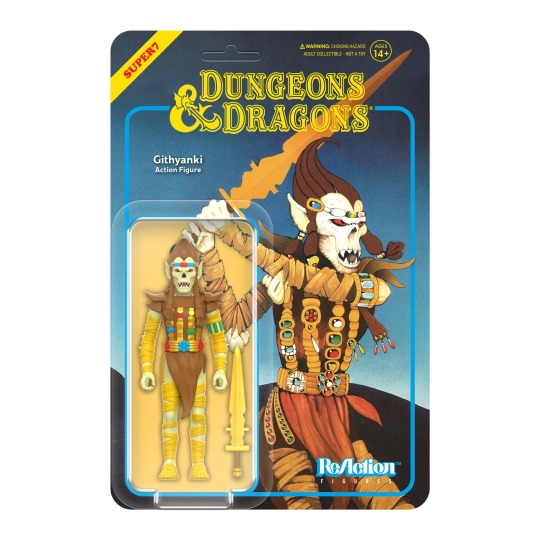

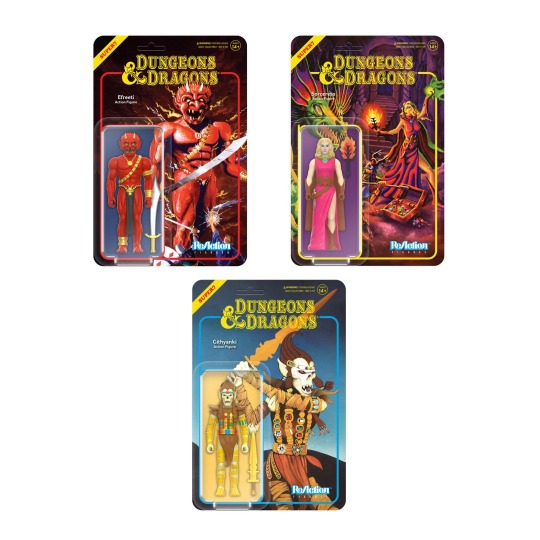

😎
#dungeons and dragons#super7#reaction figures#erol otus#david c. sutherland iii#russ nicholson#larry elmore#fantasy art#these would be so cool to have!#can we get some monster manual stuff?!
12 notes
·
View notes
Text
110. David C. Sutherland III and Gary Gygax - Q1: Queen of the Demonweb Pits (1980)
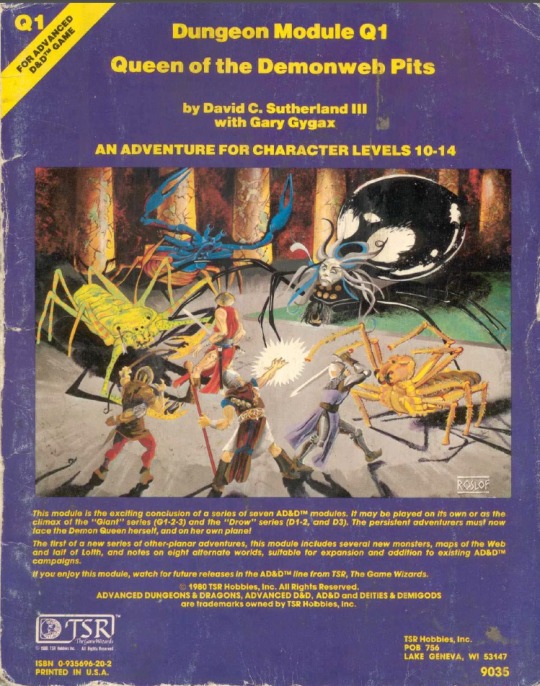
If I complained that the last module (Slave Pits of the Undercity) was too light on story and lore and just a bunch of monsters and rooms to fight in, the same cannot be said about Queen of the Demonweb Pits. This is a fantastic module in more ways than one.

A culmination to the adventures started in G1, this is the seventh module in the series and such a long run demanded an epic conclusion, this certainly is that. It's a strange and unique module as your party goes into Lolth's domain to take the fight to the Spider Goddess. On the way to her you have to go through one of the strangest maps in all of D&D, the art-like Demonweb, an interlacing web of corridors full of overpasses and underpasses as well as doors to other dimensions, teleporting and tough monsters and this is all before you get to Lolth's ship, a spider-shaped steam engine that is also the goddess' keep.
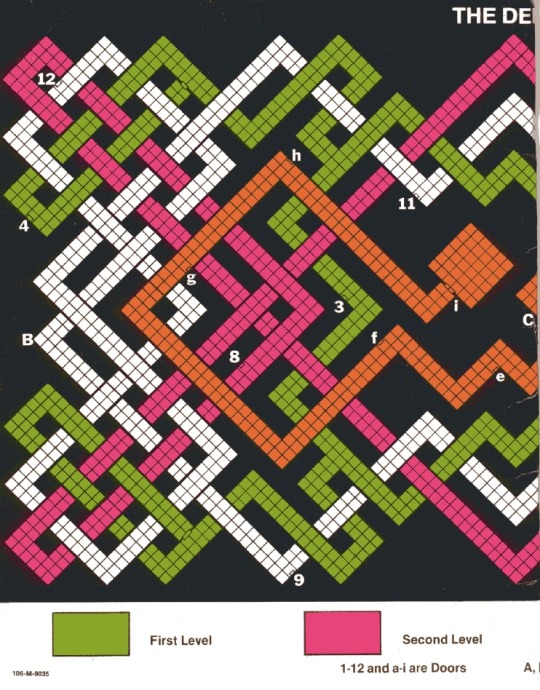
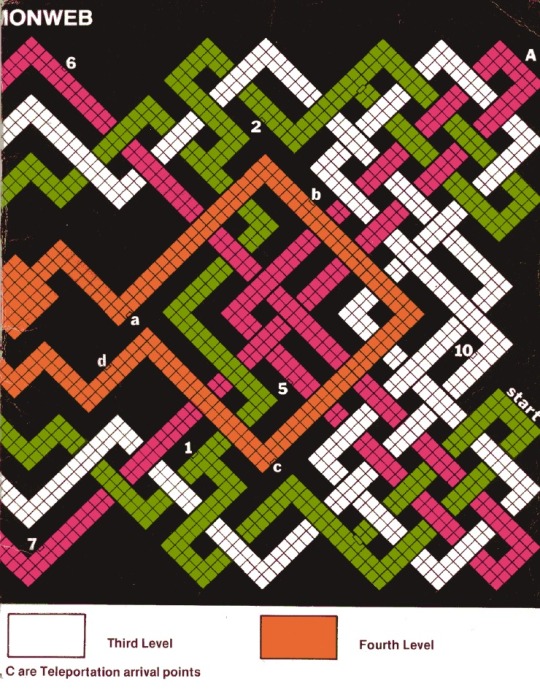
One of the coolest modules in the first decade of D&D, full of surreality and danger as well as deep lore and endless possibilities (you have a set of seven doors each leading to a different universe where characters can have independent adventures as well as optional instructions to add even more universes) this is a fitting end to the long GDQ series of modules.

#adnd#dnd#ttrpg#ad&d#d&d#dnd art#dungeons and dragons#dungeons & dragons#gary gygax#David C. Sutherland III#Lolth#Drow
6 notes
·
View notes
Text
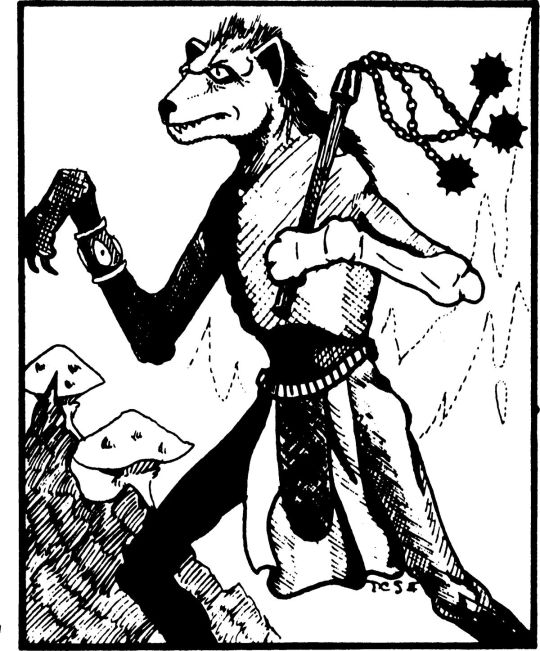
There goes Yeenoghu flailing around again… on Thac0 Thursday!!
Credit: David C. Sutherland III
#thac0 thursday#thac0#thaco thursday#thaco#d&d#dungeons & dragons movie#dnd#rpg#fantasy art#David C. Sutherland III
0 notes
Photo
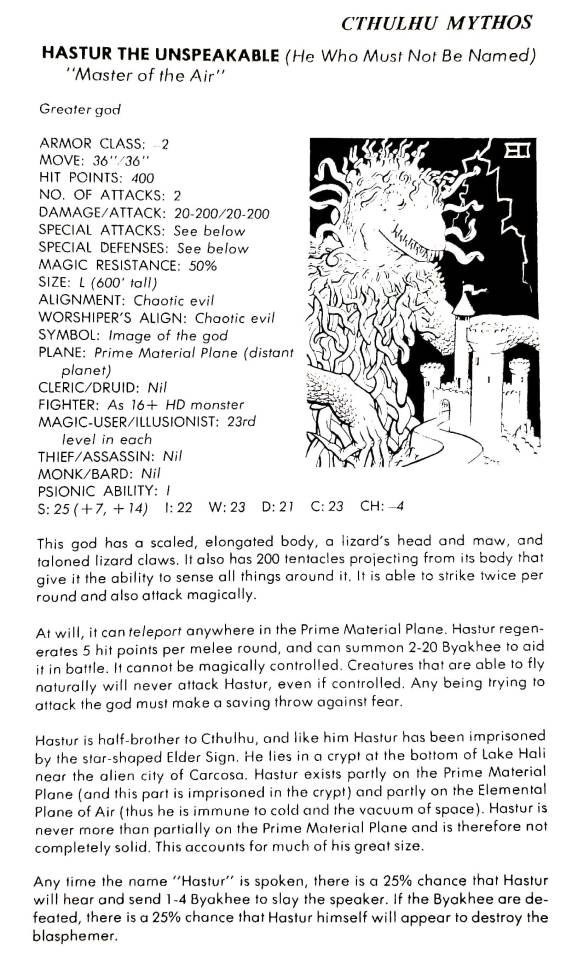

Image description: two scans from the 1980 edition of the TSR Advanced Dungeons and Dragons sourcebook Deities and Demigods. The first is of the text accompanying the entry for Hastur, a full transcript of which is under a readmore link. The second is a close-up of the illustration and depicts a lizard like creature covered in tentacles behind a castle. It is considerably larger than the castle and there is a bolt of lightning in the background. The upper right corner has a stylized signature of the letters E and O, indicating that Erol Otus is the illustrator of this particular image.
End image description.
My dad owns a copy of the Deities and Demigods book from before the copyright strike, and I haven’t seen any scans of Hastur from it around tumblr so. Here it is! The whole thing is very influenced by August Derleth’s interpretation of the Cthulhu Mythos, and I have Opinions about that, but this is specifically where the “don’t say Hastur’s name more than four times or he’ll come Get You” thing comes from, which I think is a very neat bit of history and trivia!
One other thing I find interesting is that there is no mention of The King in Yellow (the play) in this section. There is also no mention of the Yellow Sign, Cassilda, or Camilla, though Lake Hali and Carcosa are mentioned as part of an “alien planet”.
The book is credited to James M. Ward and Robert J. Kuntz, and edited by Lawrence Schick.
The illustrations are credited to the following: Jeff Dee, Erol Otus, Eymoth, Darlene Pekul, Paul Jaquays, Jim Roslof, David S. LaForce, David C. Sutherland III, Jeff Lanners, and D. A. Trampier.
Text transcript is as follows:
HASTUR THE UNSPEAKABLE (He Who Must Not Be Named) “Master of the Air”
Greater God
ARMOR CLASS: -2
MOVE: 36″/36″
HIT POINTS: 400
NO. OF ATTACKS: 2
DAMAGE/ATTACK: 20-200/20-200
SPECIAL ATTACKS: See below
SPECIAL DEFENSES: See below
MAGIC RESISTANCE: 50%
SIZE: L (600′ TALL)
ALIGNMENT: Chaotic evil
WORSHIPER’S ALIGN: Chaotic evil
SYMBOL: Image of the god
PLANE: Prime Material Plane (distant planet)
CLERIC/DRUID: Nil
FIGHTER: As 16+ HD monster
MAGIC-USER/ILLUSIONIST: 23rd level in each
THIEF/ASSASSIN: Nil
MONK/BARD: Nil
PSIONIC ABILITY: I
S: 25 (+7. +14) I: 22 W: 23 D: 21 C: 23 CH: -4
This god has a scaled, elongated body, a lizard’s head and maw, and taloned lizard claws. It also has 200 tentacles projecting from its body that give it the ability to sense all things around it. It is able to strike twice per round and also attack magically.
At will, it can teleport anywhere in the Prime Material Plane. Hastur regenerates 5 hit points per melee round, and can summon 2-20 Byakhee to aid it in battle. It cannot be magically controlled. Creatures that are able to fly naturally will never attack Hastur, even if controlled. Any being trying to attack the god must make a saving throw against fear.
Hastur is half-brother to Cthulhu, and like him Hastur has been imprisoned by the star-shaped Elder Sign. He lies in a crypt at the bottom of Lake Hali near the alien city of Carcosa. Hastur exists partly on the Prime Material Plane (and this part is imprisoned in the crypt) and partly on the Elemental Plane of Air (thus he is immune to cold and the vacuum of space). Hastur is never more than partially on the Prime Material Plane and is therefore not completely solid. This accounts for much of his great size.
Any time the name “Hastur” is spoken, there is a 25% chance that Hastur will here and send 1-4 Byakhee to slay the speaker. If the Byakhee are defeated, there is a 25% chance that Hastur himself will appear to destroy the blasphemer.
#cthulhu mythos#hastur#the king in yellow#dnd#carcosa#advanced dungeons and dragons#deities and demigods
106 notes
·
View notes
Text
No. 2 - G2, The Glacial Rift of the Frost Giant Jarl (July 1978)
Author(s): Gary Gygax
Artist(s): Erol Otus, Dave C. Sutherland III (cover), David A. Trampier
Level range: Average of 9, preferably 5+ players
Theme: Standard Swords and Sorcery
Major re-releases: G1-3 Against the Giants, GDQ1-7 Queen of the Spiders, Against the Giants: The Liberation of Geoff, Dungeon #199, Tales from the Yawning Portal
On the heels of being more impressed with G1 than I expected, will G2 be similarly impressing? Time to find out!
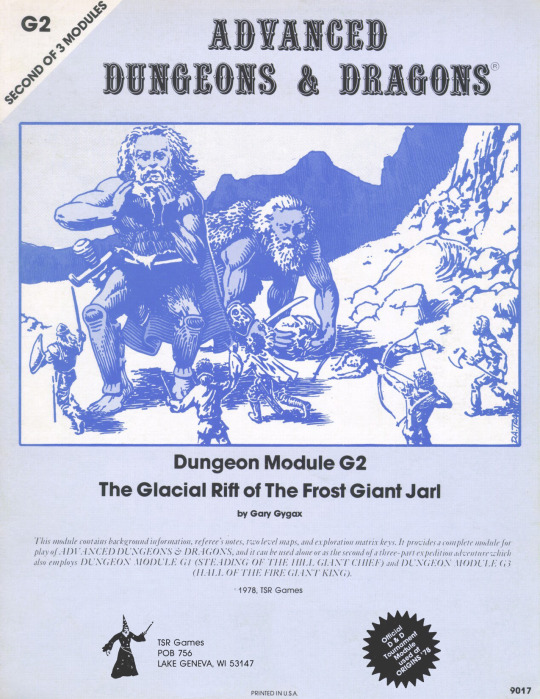
The intro blurb is mostly a repeat of the text of G1, including admonitions that running stock is for villains. Our motivation remains: figure out why the hill giants did that, no matter how fucking dangerous it is. Interestingly, the other main objective of G1 (give 'em a bloody nose) is not relevant here, because that teleport means that the frost giants aren't a threat to the villagers themselves. In fact, the room teleportation schtick kind of means G2 is filler? Like, the big reveal that the G series leads to the D series is not really impacted by the events of G2. So, oops!
Conveniently, the magical chain teleports out outside the rift so you can once again have a secret cave HQ. I feel like you have a responsibility as a GM to have a giant counterattack to at least one of these caves.

I really like the imagery of the descent into the rift here. I mean, I don't think this illustration really does it justice, imagining the deep blue color of light barely passing through the ice and how that gives the area beneath the surface an eerie oceanic glow at all times other than noon -- that's some good vibes. Gary opts for green, which is a fair enough choice. Unfortunately, Gary is more interested in simulating the mounting climbing than vibes, which means that at least one of your party members is going to fall face first into the snow drift below. Gary "generously" caps the damage at 10d6 (avg 35 dmg) -- a level 9 fighter, to be clear, has 9d10 hp (avg 45 hp) and a level 9 magic user has 9d4 hp (avg 23), so that's not ideal. Also recall that you recover 1hp per full day of rest normally, so if you fall and survive you're probably still fucked unless your cleric has a lot of spells left. I'm also pretty sure your cave HQ is above the cliff face, so, risking the descent seems like suicide to me. You're going to lose people and even leaving to heal them back up is simply taking another chance at oblivion. Take the stairs.
If you have the audacity to slow fall down, you will be blown 75ft off course in a random direction. Very cool Gary!
Another interesting detail: monsters in classic DND have a pretty short attention span and will lose you fairly quickly if you flee around a corner. This is particularly amped up here to a breezy 4 in 6 odds of success, due to blizzards blocking chase.
Anyway, we're into the room by room, so let's do some room by room shit.
There is a kind "spiked heads of our enemies at the gates" situation, with corpses mutilated and frozen in transparent ice as a warning to not intrude. Honestly that's badass. What's not badass is if the players have the wherewithal to try and free the corpses (for loot or kindness), most routes lead to the treasure being destroyed and the roof collapsing -- probably instantly killing your squishies.
The hill giants from G1 are lolling about waiting for an audience, so points for continuity. I have to imagine they're freezing their asses off, though.
There are yetis here? Which, going on the graphic and the listed intelligence score in the MonMan, I have to conclude are sentient bipedial apes but like, NOT like the Frost Giants. Actually apparently the average yeti is smarter than the average frost giant, so I guess it's a Diogenes situation where they choose to live in a shitty cave when everyone else has a nice cave?
The 5 hill giants visiting the Jarl have 1k to 6k gold fur cloaks, which like. Imagine a 6,000 gold cloak. Not only is it got to be huge (Hill Giants are 10.5ft tall), for it to be worth 6k to a vendor that's got to be a one-piece fabric cloak off a particularly rare and good condition animal. I guess the players could use it as the world's fanciest comforter?

The official appearance of a Remoraz! These are awful creatures. They swallow you whole and then superheat their insides to cook you. Nasty side effect: its outsides become furnace-hot and destroy nonmagical items and burn people to death. Look at this horrible thing! And of course it's guarding the swankiest loot to date -- a +2 Giantslaying Sword and a 3 Wishes Ring. It's been a weird trend lately that the best loot is, not owned by the leader of the Giants? The best hoard seems to always belong to Some Guy. Naturally this awesome loot "sinks into the ice" if you use a fireball, because this adventure has an addiction to telling the wizard to fuck off. Note that the sword being lost punishes the fighter for the magic users' decision. Note also that the Remoraz going into superheat mode doesn't do the same thing? It sucks. This clause sucks. Cut it. The actual room itself is kind of neat, the implication is that the Remorhaz melted a spherical hole into the ice to make a den, which is awesome.
Another iconic Garyism: ". They have had audience with the Jarl, and after a special wassail to be held on the morrow they will depart for home with a treaty scroll." Translation: They're goin to have a drinking party tomorrow to celebrate a treaty signing.
And like, one room later, we get "leman", which means lover, and "durance vile", which means long imprisonment. The text implies that basically, she's a hot butch storm giantess being held in chains until she agrees to fuck the Jarl. Gary, simply ask a tall woman out. You don't have to be weird about it.
Rather than torches, the feast hall is lit with jarred fire beetles, which is kinda cute
There is a thick iron bar that "transports whosoever is standing on the floor to the entrance of Snurre's Hall [G3]". The iron bar is a lever, obviously, but is this a lever-operated teleporter? An elevator that goes straight down? G3 eliminates the elevator theory, since apparently you can arrive here via pegasus and there are caves one can access overhead. So it's a literal teleporter, and at least how I'm reading it makes it sound more science fiction than magic. Weird.
On the whole, G2 is a massive step down from G1. G2 lacks the factionalism of G1, punishes players for damn near anything attempted, and is broadly less imaginative than G1. It's a pity, really, because it's a far more interesting locale on paper, but the reality is that you could generate a cave like this by scribbling randomly. Meh. Next time we poke G3, and hope hope hope that it's more like G1 than G2.
5 notes
·
View notes
Text


#RPGCovers Week Nine
Metamorphosis Alpha (1976)
David C Sutherland, III
This is one of those games from my childhood that I have an unreasonable fondness for. It came out in 1976, around the time I first started playing D&D thanks to my sister. We got a local games stone a couple of years later in 1978, carrying all kinds of earlier role-playing releases and wargames.
But I don’t think I saw this for another couple of years: when my sister brought it home. You have to remember print runs and distribution were wildly spotty in those days. I think she’d bought or borrowed it off of someone else. By that time I was already playing Gamma World 1e, so this felt like a throwback, a weird dead end in sci-fi gaming.
And that cover– so amateur and wildly 1970s. Even as a kid I knew this was not great art and not great layout. But it had so much going on across it and wild colors. The way the red text of the TSR push text is washed out by the background or the white on black text of the blurb on the screen kind of gets squashed and tilted.
It’s trying hard…and as a way to grab the imagination of the potential players, it does invite you to wonder: if not about the game’s story, then what was going through the artist’s mind when they put this together.
9 notes
·
View notes
Text
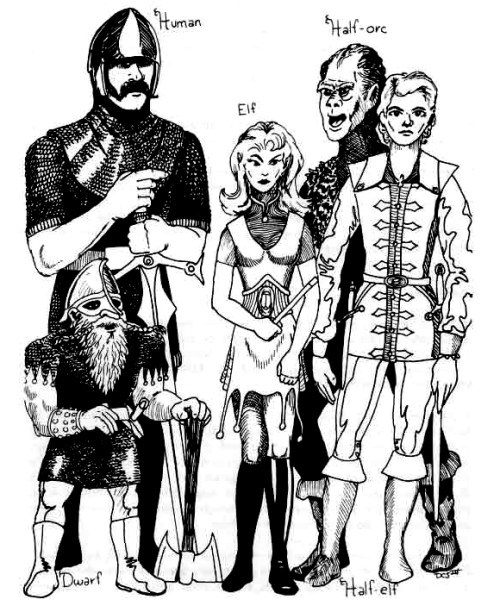
by David C Sutherland III
3 notes
·
View notes
Photo
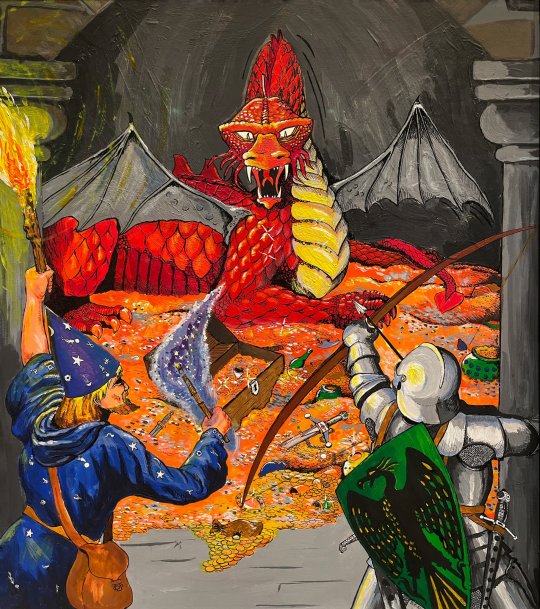
Game night! David C. Sutherland III, cover illustration for the Dungeons & Dragons Basic Set (TSR, 1977). Acrylic on board, 24 5/8 x 22 inches. Showcased in the exhibition Enchanted: A History of Fantasy Illustration, Norman Rockwell Museum, Stockbridge, Mass., summer–fall 2021.
__________________________________________________
Our shop: https://bookshop.org/shop/manyworldspress
#David c. Sutherland iii#dungeons & dragons#basic d&d#red dragon#TSR hobbies#gary gygax#dave arneson#j. eric holmes#holmes basic#gaming history#fantasy art#game art#norman rockwell museum#game night#original art
123 notes
·
View notes
Photo





This, my friends, is the Hong Kong kaiju dinosaur critter that would one day grow up to become the classic Dungeons & Dragons monster, the Owlbear.
These guys, along with what would become the rust monster and the bulette (as well as a bunch of other weirdos that never turned up in D&D), used to fill out packages of plastic toy dinosaurs. For some reason. The sort you would occasionally find at super markets or five and dimes back in the 70s and 80s (and, honestly, I’ve seen rust monsters in similar cheap-o toy packs as recently as a couple years ago in my local Foodtown). Gary Gygax used them as miniatures in his games, and thus they transcended into legend.
I wish I could talk to the person who sculpted this thing and get a sense of what they were thinking. Its so…doofy. But magical. I’ve read that these weirdos were intended to be knock-off Ultraman kaijus and that sort of makes sense – the Owlbear does look a bit like the Kappa from Japanese folklore. Kind of. But whoever made the decision to include them in the States with plastic dinosaurs was some kind of mad genius. I love it.
For whatever reason, of the three, the Owlbear is the hardest to come by. I’ve been looking for one for decades, but boy, was it worth the wait. Oh, and, a little bit of extra D&D history – this particular Owlbear was one of several owned by no less an august personage than @DiTerlizzi, who offered to sell me one when he was cleaning out his shelves. If you told me 20 years ago that THIS was how I’d finally get my hands on an Owlbear, I’d have spit in your eye and called you a no good dirty liar.
#RPG#TTRPG#Tabletop RPG#Roleplaying Game#D&D#dungeons & dragons#David C Sutherland III#Gary Gygax#Owlbear#DiTerlizzi
804 notes
·
View notes
Photo

Advanced Dungeons & Dragons - art by David C. Sutherland III (1978)
#david c. sutherland iii#advanced dungeons & dragons#70s fantasy art#monster manual#fantasy art#ad&d art#gary gygax#paladin#seventies#1978#chronoscaph scans
306 notes
·
View notes
Text
Iconic AD&D art - Top 5
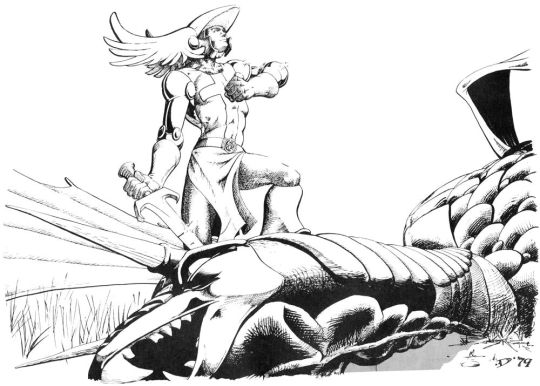
Jeff Dee, Paladin and Black Dragon, AD&D 1st edition Rogues Gallery

Russ Nicholson, Githyank and adventurers, AD&D 1st edition Fiend Folio

Erol Otus, Lolth, AD&D 1st edition Dungeon Module Q1

David C Sutherland III, ‘A Paladin in Hell’, AD&D 1st edition Players Handbook

David Trampier, ‘Emirikol the Chaotic’, AD&D 1st edition Dungeon Masters Guide
Explanation below the cut.
Obviously a list like this is highly subjective, and I should probably make it clear that by “iconic” I mean “iconic to me”, as these were a handful of the AD&D 1st edition illustrations that had a big impact on my experience with the game, and by extension, how I design characters and write adventures (for Dungeons & Dragons and beyond) to this day.
Some of my admittedly arbitrary criteria:
I made my picks from the books, modules and supplements that were on my shelves back in the day. Which isn’t a comprehensive list by any means. To me, the canon is the core three hardbacks (to this day, I think of Unearthed Arcana as new-fangled and the Survival Guides as niche products we didn’t use) plus Fiend Folio and Deities & Demigods; that run of modules that included the A, B, D, G, and S-series, plus a few others like C1 and Q1; and accessories including Rogues Gallery and the booklet of character sheets. That list is as arbitrary as it is inexhaustive.
I limited myself to black & white interior illustrations, meaning David Trampier’s superb cover for the Players Handbook was disqualified. I did it this way mostly because I felt it would be unfair to compare color paintings to ink drawings. I’m not sure if that’s true or not, but that’s how I did it. That said, had I allowed Tramp’s PH I’m actually thinking it might be the only color piece in there… The original Dungeon Masters Guide and Monster Manual covers never resonated with me to the same degree. Of the modules I included, there are three covers I really like, and they’re all by Erol Otus: A4, ‘In the Dungeons of the Slave Lords’; C1, ‘Hidden Shrine of Tamoachan’; and S3, ‘Expedition to the Barrier Peaks’. But they’re not quite iconic, somehow, in the sense that they’re too specific to the adventures they illustrate. In contract, the Players Handbook cover doesn’t tell you about someone else’s adventure, it inspires yours.
In the interest of a varied selection, I decided no one artist could be chosen more than once. This was basically to make sure Trampier and Jeff Dee didn’t crowd out other worthy illustrators.
My choices, in alphabetical order by last name:
Jeff Dee, Paladin and Black Dragon, Rogues Gallery, page 22. Paladins were always cool, and this drawing made them double extra cool. A lot of my peers complained that Dee’s characters all looked like super-heroes, and that they belonged in the pages of his Villains & Vigilantes. And that’s arguably true. But as a life-long reader of comics and V&V gamemaster, I didn’t mind at all. And that style is on display here: skintight plate and chain mail, aerodynamic helmet, and floppy fold-over Musketeer boots. But the pose is perfect, the dragon is superb, and the emotion of the paladin’s triumph shines. Jeff Dee did other illustrations that vied for his spot here: the “sci-fi Mind Flayer” and the Intellect Devourer stalking the party (both from ‘Expedition to the Barrier Peaks’), Icar holding flaming grease (frontispiece from Dungeon Module A2), and assorted entries in Deities & Demigods too numerous to mention.
Russ Nicholson, Githyanki fighting adventurers, Fiend Folio, page 45. Compared to the Monster Manual, which included so many creatures recognizable from myth and folklore, the Fiend Folio was weird. But the monsters that were cool immediately rivaled the classics, and the ones Russ Nicholson drew became my favorites. The Gith races were awesome from the get-go, and this illustration, supplementing the individual entries for the Githyanki and Githzerai, went a long way to inspiring us to put them in our dungeons. (I was so enamored of the Gith that I worked them into the origin story of a player character in the Villains & Vigilantes campaign I ran.) The adventurers here look outmatched, maybe, but they haven’t given up. We wondered what spell the Magic User was casting.
Erol Otus, Lolth frontispiece, Dungeon Module Q1, ‘Queen of the Demonweb Pits’: I love Erol Otus, but compared to Trampier and David Sutherland, his drawings could get wonky. Intentionally, I’m sure, but often his costumes and anatomy and such are a little far-fetched even for Dungeon & Dragons. (He loved horned helmets and loincloths, often on the same character.) This drawing of Lolth is great, in that it sets the stage for the adventure (in a way that Jim Rosloff’s cover doesn’t, honestly) and depicts Lolth as vampy without being overtly “sexy” like all the topless goddesses in Deities & Demigods. The demons here are especially good, with solid anatomy and dramatic lighting. This drawing is “so Erol Otus” without being “too Erol Otus”.
David C Sutherland III, ‘A Paladin in Hell’, Players Handbook, page 23. Unlike Trampier, who rarely missed, DCS was uneven: some of his drawings are classics, and many of them were mediocre then and just as mediocre now. ‘A Paladin in Hell’ is a classic, for several reasons. Firstly, it’s just really well drawn. Absent is the scratchy hatching that mars some of Sutherland’s work. Second, the paladin is perfect in the sense that he is believable; then and now I appreciate that fact that his armor is historically accurate and looks like suits I’d seen in museums. And third, the collected devils are all drawn to scale, showing their size the way Monster Manual spot illustrations don’t. Finally, the glow of the paladin, and what is surely a +5 Holy Avenger, is dazzling.
David Trampier, ‘Emirikol the Chaotic’, Dungeon Masters Guide, page 193. It’s difficult to see this drawing and not want to run a campaign set in the bustling capitol city of the Flanaess’ mightiest empire in which a villain Magic User is on a crime spree. (It’s the same feeling you get when you read any of Fritz Leiber’s stories set in Lankhmar. In fact, you want to go get the map they made for the AD&D supplement, including those awesome city geomorphs.) If Emirikol is the errant NPC, maybe the PCs are the adventurers stumbling out of the tavern into the exquisitely rendered (that hatching!) street to protect the innocent townsfolk being Magic Missiled. So who is Emirikol? He looks enough like Trampier that he could be one of many self-portraits sneaked into his AD&D artwork. (I’ve always wondered if he was Tramp’s PC in Gary Gygax’s Greyhawk campaign, though I’ve never gotten any indication that they actually gamed together.) This really cements Trampier’s stature; the Dee and Sutherland illustrations on this list evoke a single character or moment, while ‘Emirikol the Chaotic’ evokes an entire campaign. You don’t get more iconic than that.
#dungeons and dragons#D&D#AD&D#illustration#david trampier#david sutherland#jeff dee#erol otus#russ nicholson#brg
119 notes
·
View notes
Text
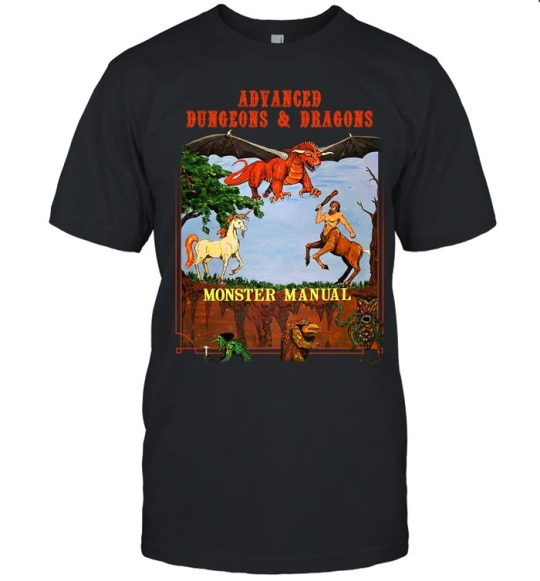

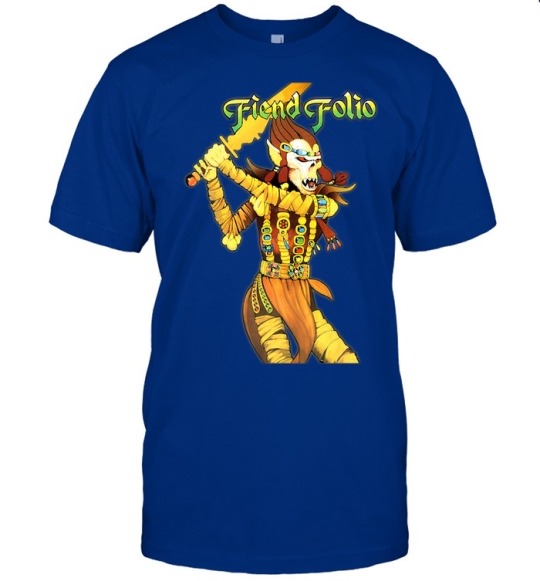
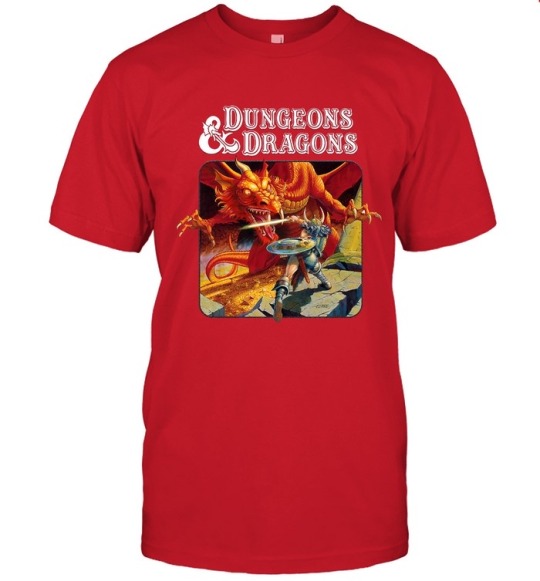
I need these!
#dungeons and dragons#monster manual#fiend folio#david c. sutherland iii#david a. trampier#russ nicholson#larry elmore#fantasy art
2 notes
·
View notes
Text
243. Jeff Easley - Dungeon Masters Guide Cover (1983)
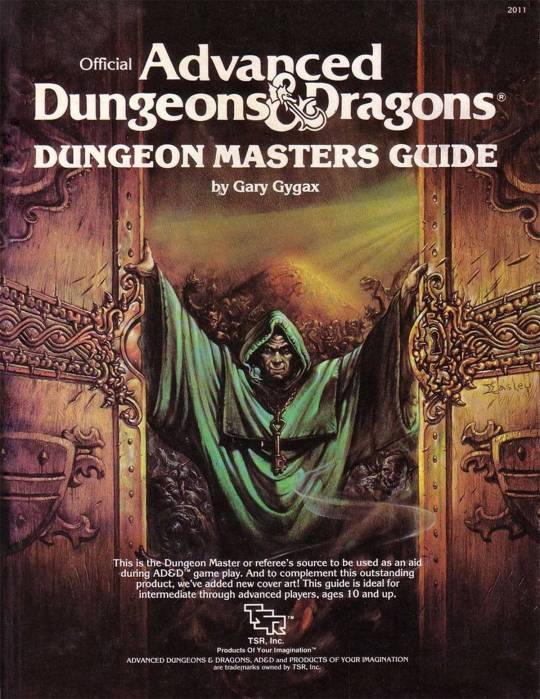
Another of the three central volumes in AD&D, this is part of the brand revamp for the game by TSR, I've already covered the Players Handbook and there's still the Monster Manual remaining.
As with all of these three volumes, the inside is exactly the same as the previous David C. Sutherland III cover volume, so there's no need to cover that. Sutherland's cover, charming as it was, would really not fit the more painterly brand identity that came with the hiring of artists such as Easley, Clyde Caldwell or Larry Elmore, which really led to a change in the look and feel of AD&D. You can go back to item #71 on this page, from 1979 to read my impressions of the original DMG and see some interior shots as well as look at the Sutherland cover.
13 notes
·
View notes
Text
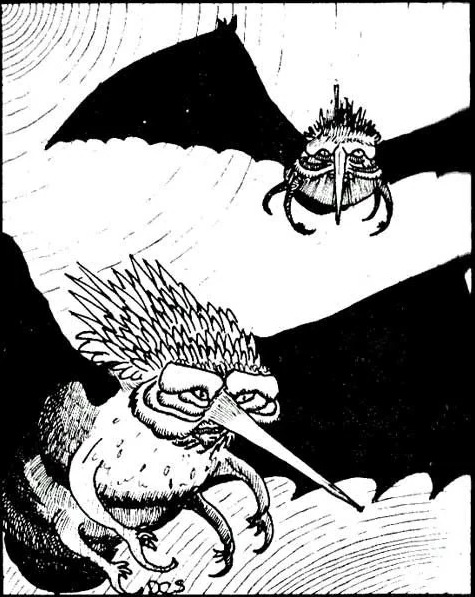
Who doesn't love a blood-sucking stirge… on Thac0 Thursday!!
Credit: David C. Sutherland III from the AD&D Monster Manual (1979)
2 notes
·
View notes
